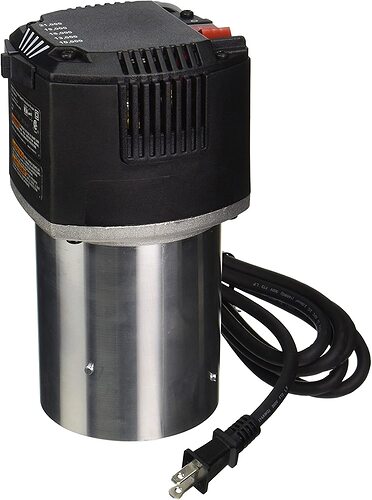The 3.25HP routers are going to be tough. They’re a LOT larger than the ones we typically use, so it starts to [resent some physical limitations.
That said, the LR3 can probably manage it, but you will need to be able to do your own design work, probably. Maybe some of us will be willing to help… but if you want it, you’ll need to be able to at least print it.
I’ll recommend anyone getting into this as a hobby have some understanding of 3D printing. It does seem that the #1 thing that people with 3D printers print though are upgrades for their 3D printers. And useless objects like Benchies, which they use to prove how effective their 3D printer upgrades are (Or are not.) I rank myself as guilty in this regard as well, though personally, I’ve never printed a Benchy. Ever. I went through a number of 3D printers before I managed to stop trying to upgrade the 3D printer, and just use it to make stuff that I wanted. (Admittedly, it recently has been doing a lot of work printing CNC parts…)
So I guess I’m guilty of developing a 3D printer good enough to make a CNC with, which was good enough to make a better 3D printer, which was good enough to make a better CNC, with which I intend to make another good 3D printer.  (Though the CNC has made a lot of other stuff for me, as have the 3D printers.)
(Though the CNC has made a lot of other stuff for me, as have the 3D printers.)
If you are willing to go with one of the palm routers that there will be purchasable parts for, you might not need the 3D printer at all. While there are similarities in the workflow, they’re separate processes, and do require different design work. Most things that you can make with a CNC router you could also 3D print, provided that your printer is large enough. Many things can be 3D printed though that you cannot do with a CNC router. At least not unless you have more than 3 axes to manipulate, and then the software starts getting crazy expensive.
As soon as you want “off the beaten path” though, you will need a 3D printer.
Choosing a 3D printer:
Something like an Ender 3 Pro is inexpensive, has good functionality and good support, including several good aftermarket upgrades. It will get you to known reasonable results quickly and inexpensively. You can go up to printers that have known excellent results, if you’re willing to spend 3 to 4 times the amount of money on one. I’d say to start with a budget. 3D printers can be had for very low dollars, if you’re willing to put in more work, or are willing to deal with questionable results. (My first 3D printer wasn’t even good enough to print its own parts, let alone any better ones, but I sure learned a lot from making it at least passable.)
Budget some for filament and consumables as well. Expect to go through a spool or so “dialling in” your printer, and figuring out what settings work for you in the environment that your printer will live in. Then expect to blow another spool or so learning how to make models that you can print. Printables or Thingiverse are all well and good, but the whole point (to me) of a 3D printer is being able to take something that existed only in your head yesterday, and holding it in your hands today. But then, to me that’s also the point of a CNC machine.
 . It comes up here quite a lot.
. It comes up here quite a lot. (Though the CNC has made a lot of other stuff for me, as have the 3D printers.)
(Though the CNC has made a lot of other stuff for me, as have the 3D printers.)
